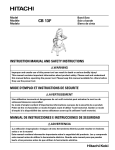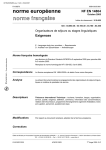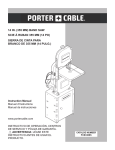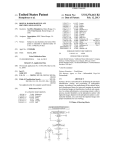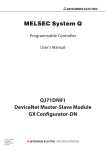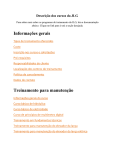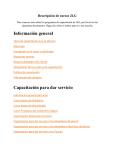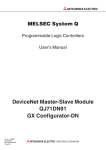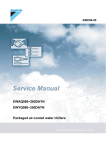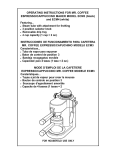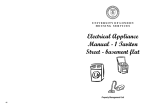Download Hitachi CB 13F User's Manual
Transcript
Model CB 13F Band Saw INSTRUCTION MANUAL AND SAFETY INSTRUCTIONS WARNING Improper and unsafe use of this power tool can result in death or serious bodily injury! This manual contains important information about product safety. Please read and understand this manual before operating the power tool. Please keep this manual available for others before they use the power tool. TABLE OF CONTENTS SECTION Page Products Specifications .......................................................... 3 Safety ...................................................................................... 4 Accessories and Attachments ............................................... 7 Carton Contents ..................................................................... 7 Know Your Band Saw ............................................................ 9 Glossary of Terms ................................................................. 10 SECTION Page Assembly and Adjustments ................................................. 11 Operation ............................................................................... 17 Maintenance .......................................................................... 20 Troubleshooting Guide ......................................................... 21 Parts List ................................................................................ 23 HITACHI AUTHORIZED SERVICE CENTERS Service under this warranty is available from Hitachi Koki U.S.A., Ltd. at : IN THE U.S.A. IN CANADA 6395 Kestrel Road Mississauga, ON L5T 1Z5 3950 Steve Reynolds Blvd. Norcross, GA 30093 9409 Owensmouth Ave. Chatsworth, CA 91311 OR CALL: (800) 546-1666 for a service center nearest you. OR CALL: (800) 970-2299 for a service center nearest you. — 2— WARNING Some dust created by power sanding, sawing, grinding, drilling and other construction activities contains chemicals known to the state of California to cause cancer, birth defects or other reproductive harm. Some examples of these chemicals are: • Lead from lead-based paints • Crystalline silica from bricks, cement and other masonry products • Arsenic and chromium from chemically treated lumber Your risk from these exposures varies, depending on how often you do this type of work. To reduce your exposure to these chemicals, work in a well-ventilated area and work with approved safety equipment such as dust masks that are specially designed to filter out microscopic particles. PRODUCT SPECIFICATIONS MOTOR Power source ........................ 120 V, AC, 60 HZ, 7AMPS. Speeds Low .......................... 1410 F.P.M (Feet per minute) High ......................... 2600 F.P.M Horsepower .......................... 1HP(Max. Developed) DRIVE BELT A 26 Cutting Capacity Throat .................................... 12” Height .................................... 5” Blade Width ..................................... 1/8”, 1/4”, 3/8”, 1/2” Length ................................... 80” Table Size ........................................ 13” x 13” Tilt .......................................... 0° Left –– 45° Right DUST COLLECTION ....................... Yes NET WEIGHT .................................. 145.5 LB (66.0Kg.) WARNING To avoid electrical hazards, fire hazards, or damage to the tool, use proper circuit protection. Use a separate electrical circuit for your tools. Your Band Saw is wired at the factory for 120V operation. Connect to a 120V, 15 AMP branch circuit and use a 15 Amp time delay fuse or circuit breaker. To avoid shock or fire, replace power cord immediately if it is worn, cut or damaged in any way. —3— SAFETY 12. ALWAYS WEAR EYE PROTECTION. Any Band Saw can throw foreign objects into the eyes that could cause permanent eye damage. ALWAYS wear Safety Goggles (not glasses) that comply with ANSI Safety standard Z87.1 Everyday eyeglasses have only impact–resistance lenses. They ARE NOT safety glasses. Safety Goggles are available at HITACHI. NOTE: Glasses or goggles not in compliance with ANSI Z87.1 could cause serious injury. GENERAL SAFETY INSTRUCTIONS BEFORE USING THE BAND SAW Safety is a combination of common sense, staying alert and knowing how to use this Band Saw. WARNING To avoid mistakes that could cause serious injury, do not plug the Band Saw in until you have read and understood the following: 1. READ and become familiar with the entire Operator’s Manual. LEARN the tool’s application, limitations and possible hazards. 13. WEAR A FACE MASK OR DUST MASK. Sawing operation produces dust. 14. SECURE WORK. Use clamps or a vise to hold work when practical. It’s safer than using your hand and it frees both hands to operate tool. 2. KEEP GUARDS IN PLACE and in working order. 15. DISCONNECT TOOLS before servicing; when changing accessories such as blades, bits, cutters, and the like. 3. REMOVE ADJUSTING KEYS AND WRENCHES. Form the habit of checking to see that keys and adjusting wrenches are removed from the tool before turning ON. 16. REDUCE THE RISK OF UNINTENTIONAL STARTING. Make sure switch is in OFF position before plugging in. 4. KEEP WORK AREA CLEAN. Cluttered areas and benches invite accidents. 5. DON’T USE IN DANGEROUS ENVIRONMENT. Don’t use power tools in damp or wet locations, or expose them to rain. Keep work area well lighted. 6. KEEP CHILDREN AWAY. All visitors should be kept a safe distance from work area. 7. MAKE WORKSHOP CHILD PROOF with padlocks, master switches, or by removing starter keys. 8. DON’T FORCE THE TOOL. It will do the job better and safer at the rate for which it was designed. 9. USE THE RIGHT TOOL. Do not force tool or attachment to do a job for which it was not designed. 17. USE RECOMMENDED ACCESSORIES. Consult the Operator’s Manual for recommended accessories. The use of improper accessories may cause serious injury. 18. NEVER STAND ON TOOL. Serious injury could occur if the tool is tipped or if the cutting tool is unintentionally contacted. 10. USE PROPER EXTENSION CORD. Make sure your extension cord is in good condition. When using an extension cord, be sure to use one heavy enough to carry the current your product will draw. An undersized cord will result in a drop in line voltage and in loss of power that will cause the tool to overheat. The table on page 7 shows the correct size to use depending on cord length and nameplate ampere rating. If in doubt, use the next heavier gauge. The smaller the gauge number, the heavier the cord. 11. WEAR PROPER APPAREL. Do not wear loose clothing, gloves, neckties, rings, bracelets, or other jewelry that may get caught in moving parts. Non-slip footwear is recommended. Wear protective hair covering to contain long hair. 19. CHECK FOR DAMAGED PARTS. Before further use of the tool, a guard or other part that is damaged should be carefully checked to determine that it will operate properly and perform its intended function – check for alignment of moving parts, binding of moving parts, breakage of parts, mounting, and any other conditions that may affect its operation. A guard or other part that is damaged should be properly repaired or replaced. 20. NEVER LEAVE TOOL RUNNING UNATTENDED. TURN POWER “OFF”. Don’t leave tool until it comes to a complete stop. 21. DON'T OVERREACH. Keep proper footing and balance at all times. 22. MAINTAIN TOOLS WITH CARE. Keep tools sharp and clean for best and safest performance. Follow instructions for lubricating and changing accessories. 23. DO NOT use power tools in the presence of flammable liquids or gases. —4— 24. DO NOT OPERATE the tool if you are under the influence of any drugs, alcohol or medication that could affect your ability to use the tool properly. 14. CUT only one work-piece at a time. Make sure the table is clear of everything except the work-piece and its guides before you turn the saw on. 25. ALWAYS operate the band saw in a well-ventilated area and provide for proper dust removal. Use dust collection systems whenever possible. Dust generated from certain materials can be hazardous to your health. 15. ALWAYS WATCH the saw run before each use. If there is excessive vibration or unusual noise, stop immediately. Turn the saw OFF. Unplug it immediately. Do not start the saw again until the problem has been located and corrected. 16. TO FREE any jammed material, turn the switch OFF. Remove the switch key and unplug the saw. Wait for all moving parts to stop before removing jammed material. SPECIFIC SAFETY INSTRUCTIONS FOR BAND SAWS 1. TO AVOID INJURY from unexpected movement, make sure the saw is on a firm, level surface, properly secured to prevent rocking. Make sure there is adequate space for operating. Bolt the saw to a support surface to prevent slipping, walking, or sliding during operation. 2. TURN the saw OFF and unplug the saw before moving it. 3. USE THE CORRECT size and style of blade. 4. USE blades rated at 2700 FPM or greater. 5. MAKE SURE the blade teeth point down and towards the table. 6. BLADE GUIDES, SUPPORT BEARINGS, AND BLADE TENSION must be properly adjusted to avoid accidental blade contact and to minimize blade breakage. To maximize blade support, always adjust the upper blade guide and blade guard so that it is 1/8 inch above the work-piece. 7. TABLE LOCK HANDLE should be tight. 8. USE EXTRA CAUTION with large, very small or awkward work-pieces. 9. USE EXTRA SUPPORTS to prevent work-pieces from sliding off the table top. Never use another person to support the work-piece. 17. DON’T LEAVE the work area until all moving parts are stopped. To child-proof the workshop, shut OFF the power to master switches and remove the switch key from the band saw. Store it in a safe place, away from children. WARNING For your own safety, read the entire instruction manual before operating the band saw. 1. Wear eye protection. 2. Do not wear gloves, necktie, or loose clothing. 3. Make sure the saw is on a firm level surface and properly secured. 4. USE ONLY THE RECOMMENDED ACCESSORIES. 5. Use extra caution with very large, very small, or awkward work-pieces. 6. Keep hands away from the blade at all times to prevent accidental injury. 7. Do not remove jammed cutoff pieces until the blade has stopped. 8. Maintain proper adjustment of blade tension, blade guides and thrust bearings. 9. Adjust upper guide to just clear the work-piece. 10. Hold the work-piece firmly against the table. ELECTRICAL REQUIREMENTS POWER SUPPLY AND MOTOR SPECIFICATIONS WARNING 10. WORK-PIECES must be secured so they don’t twist, rock, or slip while being cut. 11. PLAN intricate and small work carefully to avoid pinching the blade. Avoid awkward operation and hand positions to prevent accidental contact with the blade. 12. SMALL PIECES should be secured with jigs or fixtures. Do not hand hold pieces that are so small your fingers are under the blade guard. 13. SUPPORT round work properly (with a V-block or clamped to the miter gauge) to prevent it from rolling and the blade from biting. To avoid electrical hazards, fire hazards, or damage to the tool, use proper circuit protection. Use a separate electrical circuit for your tools. Your saw is wired at the factory for 120V operation. Connect to a 120V, 15 Amp circuit and use a 15 Amp time delay fuse or circuit breaker. To avoid shock or fire, if power cord is worn or cut, or damaged in any way, have it replaced immediately. GROUNDING INSTRUCTIONS WARNING This tool must be grounded while in use to protect the operator from electrical shock. —5— IN THE EVENT OF A MALFUNCTION OR BREAKDOWN, grounding provides a path of leas t res is tance for electric current and reduces the ris k of electric s hock. T his tool is equipped with an electric cord that has an equipm entgrounding conductor and a grounding plug. T he plug M U S T be plugged into a m atching receptacle that is properly ins talled and grounded in accordance with A LL local codes and ordinances . Fig. A 3-Prong Plug G rounding Prong DO NOT MODIFY THE PLUG PROVIDED. If it will not fit the receptacle, have the proper receptacle ins talled by a qualified electrician. Properly G rounded 3-Prong R eceptacle Fig. B IMPROPER CONNECTION of the equipm ent-grounding conductor can res ult in ris k of electric s hock. T he conductor with green ins ulation (with or without yellow s tripes ) is the equipm ent-grounding conductor. If repair or replacem ent of the electric cord or plug is neces s ary, DO N OT connect the equipm ent-grounding conductor to a live term inal. G rounding Lug M ake S ure T his is Connected to a K nown G round 2-Prong R eceptacle A dapter CHECK with a qualified electrician or s ervice pers on if you do not com pletely unders tand the grounding ins tructions , or if you are not s ure the tool is properly grounded. USE ONLY 3-wire extension cords that have 3-prong grounding plugs and 3-pole receptacles that accept the tool's plug. Repair or replace damaged or worn cord immediately. T his band s aw is for indoor us e only. Do not expos e to rain or us e in dam p locations GUIDELINES FOR EXTENSION CORDS U s e a s eparate electrical circuit for your tools . T his circuit m us t not be les s than # 12 wire and s hould be protected with a 15 A m p tim e delay fus e. B efore connecting the m otor to the power line, m ake s ure the s witch is in the OFF pos ition and the electric current is rated the s am e as the current s tam ped on the m otor nam eplate. R unning at a lower voltage will dam age the m otor. T his tool is intended for us e on a circuit that has a receptacle like the one illus trated in Figure A . s hows a 3-prong electrical plug and receptacle that has a grounding conductor. If a properly grounded receptacle is not available, an adapter (Figure B ) can be us ed to tem porarily connect this plug to a 2-contact ungrounded receptacle. T he adapter (Figure B ) has a rigid lug extending from it that M U S T be connected to a perm anent earth ground, s uch as a properly grounded receptacle box. T HE T E N POR A R Y A DA PT E R S HOU LD B E U S E D ON LY U N T IL A PR OPE R G R OU N DE D PU T LE T CA N B E IN S T A LLE D B Y A QU A LIFIE D E LE CT R ICIA N . T he Canadian E lectrical Code prohibits the us e of adapters . CAUTION: In all cas es , m ake certain the receptacle is properly grounded. If you are not s ure, have a qualified electrician check the receptacle. WARNING WARNING USE PROPER EXTENSION CORD. M ake s ure your extens ion cord is in good condition. W hen us ing an extens ion cord, be s ure to us e one heavy enough to carry the current your product will draw. A n unders ized cord will caus e a drop in line voltage, res ulting in los s of power and caus e overheating. T he table below s hows the correct s ize to us e depending on cord length and nam eplate am pere rating. If in doubt, us e the next heavier gauge. T he s m aller the gauge num ber the heavier the cord. Be sure your extension cord is properly wired and in good condition. A lways replace a dam aged extens ion cord or have it repaired by a qualified pers on before us ing it. Protect your extens ion cords from s harp objects , exces s ive heat and dam p or wet areas . MINIMUM GAUGE FOR EXTENSION CORDS (AWG) (When using 120 Volt only) A m pere R ating N ot M ore T han M ore T han 0 6 6 10 10 12 12 16 T his tool is for indoor us e only. Do not expos e to rain or us e in dam p locations . —6— T otal length in feet 25' 18 18 16 14 50' 16 16 16 12 100' 150' 16 14 14 12 14 12 N ot A pplicable ACCESSORIES AND ATTACHMENTS RECOMMENDED ACCESSORIES 䢇 WARNING 䢇 To avoid injury: 䢇 Use only accessories recommended for this band saw. 䢇 Follow instructions that accompany accessories. Use of improper accessories may cause hazards. Use only accessories designed for this band saw to avoid injury from thrown broken parts or workpieces. Do not use any accessory unless you have completely read the instruction or operator’s manual for that accessory. ITEM Blade width: 1/8”,1/4”,3/8”,1/2” Blade length: 80” CARTON CONTENTS UNPACKING AND CHECKING CONTENTS TABLE OF LOOSE PARTS Carefully unpack the band saw and all its parts, and compare against the illustration following. Place the saw on a secure surface and examine it carefully. ITEM WARNING 䢇 䢇 䢇 To avoid injury from unexpected starting, do not plug the power cord into a power source receptacle during unpacking and assembly. This cord must remain unplugged whenever you are assembling or adjusting the saw. Although compact, this saw is heavy. To avoid back injury, get help whenever you have to lift the saw. If any part is missing or damaged, do not plug the band saw in until the missing or damaged part is replaced, and assembly is complete. DESCRIPTION BAND SAW: A. Band saw with motor B. Table with extension wing C. Trunnion support bracket D. Miter gauge E. Sawdust port F. Power cord hooks Foot pads G. Hex. Bolt & nuts H. Hex. Bolt I. Knobs J. Hex. Key K. Screws L. Long hex. Bolt M. Hex. Nuts N. Large washers LEG STAND: O. Leg stand top plate P. Short lower brackets Q. Long lower brackets R. Legs S. Bag: Carriage bolts Hex. Nuts Washers —7— QUANTITY 1 1 1 1 1 2 4 1 4 2 1 2 1 4 8 1 2 2 4 32 32 32 UNPACKING YOUR BAND SAW B C E D G J H A K L F I O N M P Q R S —8 — KNOW YOUR BAND SAW Blade tension knob Upper blade wheel Lower blade support bearing Blade guard Lower blade guide Upper blade support bearing Upper blade guide Upper cover Table insert Miter gauge Table aligning pin ON/OFF switch Tilt bevel scale Table removed for clarity of illustration Lower blade wheel Lower cover V-Belt Mounting holes Upper blade guide lock knob Upper blade guide rod Blade tension gauge Blade tracking knob Power cord wrap Motor pulley Blade Miter slot Table V-Belt tension lock Table trunnion Table lock plate Sawdust port Motor cord Motor Stand top table Leg stand —9— GLOSSARY OF TERMS BAND SAW TERMS BLADE GUIDES — Support the blade and keep it from twisting during operation. Blade guides must be adjusted when blade is changed or replaced. BLADE TENSION KNOB — Controls the amount of blade tension when changing blades. KERF — The material removed by the blade in a through cut, or the slot produced by the blade in a non-through or partial cut. LEADING EDGE — The front edge of the workpiece pushed into the cutting tool first. MITER CUT — An angle cut made across the width of a workpiece. BLADE TRACKING KNOB — Adjusts blade position so blade always runs in the center of the wheel. RESAW — A cutting operation to reduce the thickness of the workpiece to make thinner workpiece. ON/OFF SWITCH — Has a built-in child safety lock. To lock the switch in the OFF position, remove the switch key from the switch. RESIN — A sticky sap that has hardened. RIPPING CUT — A cutting operation along the length of the workpiece. RELIEF CUT —Removal of waste material by a cut from the outside edge, allowing easier cutting of intricate curves. R.P.M. — Revolutions per minute. The number of turns completed by a spinning object in one minute. SAWDUST PORT — Helps keep the machine free from sawdust. The sawdust port makes an excellent hook-up for a wet/dry vacuum. SAW BLADE PATH — The area of the workpiece or table top directly in line with the travel of the blade or the part of the workpiece that will be cut. TABLE LOCK KNOB — Locks the table in place. SET — The distance between two saw blade teeth tips, that are bent outward in opposite directions to each other. The further apart the tips are, the greater the set. TILT (BEVEL) SCALE — Shows the degree the table is tilted for bevel cutting. UPPER GUIDE LOCK KNOB — Locks the upper slide. Use it after adjusting the upper guide assembly to make sure upper blade guide just clears workpiece before cutting. Upper guide lock knob must be tightened before the band saw is turned on. TRAILING EDGE — The workpiece edge last cut by the blade. WORKPIECE — The item being cut. The surfaces of a workpiece are commonly referred to as faces, ends and edges. WOODWORKING TERMS WORKTABLE — The surface on which the workpiece rests while performing a cutting or sanding operation. BEVEL CUT — An angle cut made through the face of a workpiece. COMPOUND CUT — A simultaneous bevel and miter cut. CROSSCUT — A cut made across the width of the workpiece. Leading Edge F.P.M. — Feet per minute. Used in reference to the surface speed of the saw blade. Kerf Relief cut Sawblade Path Surface FREE HAND — Performing a cut without using a fence (guide), hold-down or other proper device to prevent the workpiece from twisting during the cutting operation. GUM — A sticky sap-based residue from wood products. HEEL — Misalignment of the blade. — 10 — Workpiece Trailing Edge ASSEMBLY AND ADJUSTMENT ESTIMATED ASSEMBLY TIME 35~50MINUTES ASSEMBLY INSTRUCTIONS WARNING Although compact, this saw is heavy. To avoid back injury, get help to lift the saw. Philips screwdriver Combination square Adjustable wrench Straight edge ASSEMBLE BAND SAW TO LEG STAND (Fig. B) 1. Lift the saw body (1) and place on the leg stand (2), aligning the mounting holes (3) of the saw base with the four mounting holes of the leg stand top plate. 2. Attach the band saw to the stand with four long hex head bolts (4) and four flat washers (5). 3. Place a flat washer (5) and hex nut (6) on each bolt from the underside. Hand tighten. 4. Tighten all mounting bolts and nuts with a wrench. 5. Tighten all leg stand bolts and nuts with a wrench. Feeler gauge - size 0.02 Fig. B WARNING 1 For your safety, never connect plug to power source receptacle until all assembly and adjustment steps are completed, and you have read and understood the safety and operating instructions. 4 5 3 2 LEG STAND ASSEMBLY (Fig. A) 1. Lay the top plate (1) upside down on a flat surface. 2. Attach a leg (2) to the outside of the stand top plate with four carriage bolts (3), washers (4), and nuts(5). Do not tighten. 3. Repeat for the remaining three legs. 4. Attach two long brackets (6) and two short brackets (7) to the inside for the legs, using carriage bolts (3), washers (4), and nuts (5). Do not tighten. 5. Place the leg pads (8) on each leg and turn the leg stand upright on a firm level surface. 6. Adjust the stand for stability. Fig. A 5 6 11 12 1 54 2 7 3 THE SAWDUST PORT (Fig. C) The sawdust port has a 2-1/2"(O.D) /2-1/4"(I.D) diameter opening, suitable for attaching to a wet / dry vacuum hose, to help keep the work area free of sawdust. 1. Remove the bolts (1) and washers (2) from the sawdust port (3). 2. Open the wheel cover (4). 3. Attach the sawdust port to the edge of the wheel cover, using the same hex. head bolts and washers. 4. Tighten the bolts and close the cover. 6 8 — 11 — Fig. C 6. 7. 8. 4 3 1 9. Turn the table right side up. Remove the table insert (13) from the table. Guide the table slot (14) over the saw table and rotates 1/4 turn, so the slot is perpendicular to the blade. Placing the scale lock knob bolts (10) through the trunnion bracket holes (15) as shown, lower the table onto the trunnion bracket. Fig. E 13 14 2 10 ASSEMBLE THE BAND SAW TABLE (Fig. D, E, F) Mounting the trunnion support bracket (Fig. D) 1. Remove the two hex head bolts (1) and washers (2), located on the lower band saw housing. 2. Place the trunnion support bracket (3) on the saw body, as shown, aligning the mounting holes. 3. Place the washers on the hex head bolts, and insert into the threaded holes, through the bracket and saw body. Tighten. 4. Thread a nut (4) onto the table stop bolt (5) and screw bolts into the rear tab (6) on the trunnion support bracket. 5. Tighten the nut down onto the bracket tab. Fig. D 15 13. Place a lock knob (16) on each scale knob bolt adjust the table by aligning the zero scale mark to the scale pointer (17), and tighten the knob. 14. Replace the table insert (13), aligning the indents. 15. Place the table aligning pin (18) in the hole at the front of the table, and tighten. Fig. F 13 5 4 1 2 6 3 17 16 — 12 — 18 INSTALLING AND REMOVING THE BLADE(Fig.G) WARNING! To avoid injury from accidental starting, always turn the switch OFF and remove the plus from the power source before moving, replacing, or adjusting the blade. Removing 1. Loosen the blade tension by turning the blade tension knob (1) counterclockwise. 2. Remove the table insert (2) and the table aligning pin (3) from the table. Unlock the lock knobs (12) under the table. Unfasten the screw (13) at the right of extension tube and remove the extension table from the table. 3. Open up wheel cover door (4). 4. Loosen the two Phillips screws (5) and remove the upper blade guard (6). 5. Release the lock knobs (12) under the table, then remove the screw (13) at the right of extension tube and the extension table. 6. Remove the blade (7) from the upper and lower blade guides (8). 7. Carefully pull the blade from the side slot (9) and from the wheels (10). 8. Swing the left side of the blade toward you, turning the blade so it will fit through the slot (11) in the table, and remove. Fig. G Installing 1. Make sure the blade tension knob (1) turned counterclockwise until it stops. 2. Remove old blade as explained in "Removing". 3. Guide the new blade teeth are pointing forward and down. NOTE: To avoiding lifting the workpiece, the blade teeth must point downward toward the table. 4. Swinging the left side off the blade away and back, place the blade on the upper and lower wheels (10). 5. Place the blade carefully between the upper and lower blade guides (8). 6. Slide the blade into the slot (9) at the left of the wheels, and make sure the blade is positioned at the middle of the wheels. 7. Turning the blade tension knob (1) clockwise, tighten the tension until the blade is tight on the wheels. 8. Replace the table insert (2) and the table aligning pin (3). Install the extension table and fasten the screw (13) at the right of extension tube. Lock the lock knobs (12) under the table. 9. Adjust the blade tracking and tension properly (See ADJUSTMENT INSTRUCTIONS section) before operation the band saw. WARNING 1 To avoid injury, the blade tension, tracking, and upper and lower guides and bearings must be properly adjusted before operating the band saw. (See ADJUSTMENT INSTRUCTIONS section) 10 MITER GAUGE (Fig. H) A miter gauge (1) is supplied with your band saw to be used in the table slot (2) on the right side of the blade. The miter gauge can be tilted 0 to 45 deg. right or left to maintain an accurate angle for your workpiece. A bracket is provided on the leg stand for convenient miter gauge storage. 6 5 8 9 7 4 2 11 Fig. H 1 3 8 2 10 13 12 WARNING Before operation always make sure the blade is in center of table insert slot. — 13 — INSTALL POWER BCORD BRACKETS (Fig. I) 1. Power cord brackets (1) are provided for convenient cord storage. Attach the power cord brackets to the back of the saw body, as shown, with two Phillips head screws (2). Tighten. 2. Wrap the power cord onto the brackets when the band saw is not in use, to prevent damage to the cord. Fig. I 2 ADJUSTING THE 90° TABLE STOP (Fig. K) 1. Loosen the table lock knobs (2) and tilt the table to the right. 2. Loosen the nut (4) on the table stop bolt (5) and lower the stop bolt as far as possible. 3. Tilt the table until rests on the stop bolt. 4. Place a combination square (6) on the table with the heel of the square against the saw blade 5. Adjust the tilt of the table left or right until it is 90° to the blade. Male sure there is no space between the square and the blade. Tighten the table lock knobs. 6. Adjust the table stop bolt up until it touches the table. 7. Loosen the lock knobs and see that the table is resting on the stop bolt. 8. Check the square to make sure the table is still square to the blade. If not, readjustment the stop bolt. 9. When the adjustment is accurate at 90°, align the pointer (7) to 0° the scale (8) Fig. K 1 5 6 ADJUSTMENT INSTRUCTIONS WARNING To avoid injury, turn the switch OFF and unplug the band saw from the power source before making any adjustments. 8 TABLE ADJUSTMENTS (Fig. J, K) Tilting the table (Fig. J) The band saw table (1) tilts 0° to 45° right 1. 2. 3. 7 Loosen both table lock knobs (2) underneath the table. Tilt the table to the desired angle on the scale (3) underneath the table. Tighten the two table lock knobs. 1 Fig. J 2 3 2 — 14 — 4 5. BLADE TENSION(FIG. L) WARNING 6. To avoid injury, turn the switch OFF and disconnect the saw from the power source before making any adjustments. NEVER make tension adjustments with the machine running. If the blade moves toward the front of the wheel, turn the tracking knob (5) on the rear of the band saw clockwise. This tilts the top of the wheel and moves the blade toward the center. If the blade moves toward the back edge, turn the tracking knob counterclockwise, moving the blade toward the center. NOTE: Turn the tracking knob SLIGHTLY to make blade tracking adjustments. Fig. M The gauge (1) on the bracket (2) at the rear of the upper wheel housing indicates the proper tension for the various blade widths. 1. 2. 3. Set the blade tension gauge to correspond with the width of the blade in use. Turn the blade tension knob (3) clockwise, raising the upper wheel to tighten the blade. Turn the knob counterclockwise to lower the upper wheel, loosening the blade. As you become familiar with the saw, you may want to change the tension settings. NOTE: Changes in blade width and type of material being cut will have an effect on the blade tension. Too much or too little tension could break the blade. When the band saw is not in use, relax the blade tension. 5 4 3 2 Fig. L 1 3 UPPER BLADE GUIDE ASSEMBLY (FIG. N) 2 WARNING 1 To avoid injury, turn the switch OFF and disconnect the saw form the power source before making any adjustments. NEVER make adjustments with the machine running; 1. 2. Loosen the lock knob (1) and move the blade guide assembly (2) up or down to 1/8” above the workpiece. Tighten the lock knob. Fig. N BLADE TRACKING (FIG. M) WARNING 1 To avoid injury, turn the switch OFF and disconnect the saw from the power source before making any adjustments. NEVER make tension adjustments with the machine running. 1. 2. 3. 4. The blade (1) must be tensioned properly before adjusting the tracking. Open blade (1) the upper cover. Move the blade guides (2) and support bearings (3) away from the blade, if necessary. See page 15 for bearing and guide adjustment. Rotate the wheel (4) slowly forward by hand, and check the position of the blade on the wheel. The blade should remain centered on the wheel as it turn. — 15 — 2 UPPER BALDE GUIDES AND BLADE SUPPORT BEARING (Fig. O, P) Fig. P WARNING 䢇 The blade guard has been removed for clarity of illustration. To avoid injury never operate the band saw without all guards in place and in working order. 䢇 To avoid injury, turn the switch OFF and disconnect the saw from the power source before making any adjustments. NEVER make adjustments with the machine running. NOTE: Make sure the blade is tensioned and tracking properly. Adjust the blade guides and support bearing after each blade tension and tracking adjustment. When the upper blade guides and support bearings are adjusted, the lower guides and bearing should also be adjusted. Blade guides (Fig. O) 1. Make sure the blade is tensioned and tracking properly. 2. Loosen the front hex socket screws (1) with a hex wrench. 3. Move the guides (2) as close to the blade (3) as possible without pinching it. 4. Using a feeler gauge, make sure the space between each guide and the blade measures 0.02”. (the thickness of a dollar bill) 5. Tighten the hex socket screws. 6. Loosen the side hex socket screw (4) by turning counterclockwise. 7. Move the blade guides bracket shaft (5) in or out until the guides are at least 1/32” behind the blade teeth. 8. The guides must remain behind the blade teeth during operation to prevent damage to the saw blade. 9. Tighten the hex socket screw. 1/64” 6 7 8 LOWER BLADE GUIDES AND SUPPORT BEARING WARNING To avoid injury, turn the switch OFF and disconnect the saw from the power source before making any adjustments. NEVER make adjustments with the machine running. NOTE: Make sure the blade is tensioned and tracking properly. The lower blade guides and support bearings should always be adjusted after the blade is tensioned, the tracking is adjusted, and the upper blade guides and upper support bearings are properly adjusted. Blade guides (Fig. Q) 1. Loosen both front hex socket screws (1) with a hex wrench. 2. Move the guides (2) as close to the sides of the blade (3) as possible without pinching it. 3. Using the feeler gauge, measure the spaces between the guide and the blade. Adjust to 0.02” 4. Tighten the hex screws. 5. Loosen the side hex socket screw (4). Move the guide support bracket (5) in or out until the guides are at least 1/32” behind the saw teeth. Tighten the screw. Fig. O 2 1 3 3 Fig. Q 4 2 8 5 3 1 2 Support bearing (Fig. P) 10. Loosen the bearing hex socket screw (6). 11. Move the support bearing shaft (7) in or out, until the bearing (8) is 1/64” behind the blade. 12. Tighten the hex socket screw (6). NOTE: The blade support learning prevent the blade from moving back too far and damaging the saw teeth setting. — 16 — 1 5 4 Support bearing (Fig. R) 6. Loosen the bearing hex socket screw (7) with the hex wrench. 7. Move the blade support bearing shaft (8) in or out until the support beating (9) is 1/64 " behind the saw blade. 8. Tighten the beating hex socket screw. Fig. R 1. Place a straight edge in the front groove of both pulleys, behind the blade wheel. 2. Turn the hex socket screw (1) in the side of the motor pulley (2) to loosen the pulley on the shaft. 3. Adjust the motor pulley in or out on the motor shaft (3) to align the edges of the two pulleys. 4. When aligned, tighten the hex socket screw on the side of the motor pulley. Fig. S 2 7 3 9 8 1 MOTOR Pulley alignment (Fig. S) The pulley alignment is adjusted properly at the factory and should not need readjustment. If adjustment is needed , or the belt needs replacing: 3 1 OPERATION BASIC SAW OPERATIONS Fig. T ON / OFF SWITCH (Fig. T) The keyed switch is intended to prevent unauthorized use of the band saw. 1. To turn the band saw ON insert the yellow key (1) into the key slot in the center of the switch. 2. Push the key firmly into the slot, then push switch to the ON position to start the band saw. 3. To turn the band saw OFF push the switch to the down position. 4. Remove the yellow switch key, when the saw has come to a complete stop, by gently pulling it outward. 1 WARNING Remove the switch key whenever the saw is not in use. Place it in a safe place and out of reach of children. USING THE TABLE EXTENSION (Fig. T-1) NOTE: A. For ripping 5-3/4"~ 7-1/2" workpiece, the extension fence has to be installed in the IN-RIP position (Fig. P). Remove the lock handles (1) and fence. Place the fence on extension table as shown. Raise the fence to a position that just clears the table surface and secure in place using lock handles (1) for IN-RIP position. B. For ripping 7-1/2 "~ 12 " workpiece, the extension fence has to be installed in the OUT-RIP position. — 17 — 1. Release both cam locking levers. 2. Slide the table extension on the side your workpiece will be needing support, and tighten both cam locking levers. Slide the extension out until the correct measurement is displayed on the tube scale. GENERAL CUTTING Fig. T-1 CUTTING CURVES When cutting curves, carefully turn the workpiece so the blade follows without twisting, If the curve is so sharp that you repeatedly back up and cut new kerf, use a narrower blade, or a blade with more set (teeth further apart). When a blade has more set, the workpiece turns easier but the cut is rougher. When changing a cut, do not withdraw the workpiece from the blade. The blade may get drawn off the wheels. To change a cut, turn the workpiece and saw out through the scrap material area. When cutting long curves, make relief cuts as you go along. WARNING For your safety, read and understand all GENERAL and SPECIFIC SAFETY INSTRUCTIONS on pages 4-6 before using the band saw. Operating band saws involves a certain amount of hazard. Before attempting regular work, use scrap lumber to check the settings and to get the feel of operating the band saw. Read instructions and plan your work before cutting a workpiece. CIRCLE CUTTING (Fig. U) 1. Adjust the guide assembly to 1/8 " above the workpiece. 2. Use both hands while feeding the work into the blade. Hold the workpiece firmly against the table. Use gentle pressure. Do not force the work, ALLOW the blade to cut. 3. The smallest diameter circle that can be cut is determined by the width of the blade. For example, a 1/4 " wide blade will cut a minimum diameter of approximately 1-1/2 ". Fig. U Do not turn the power ON until after you have made all adjustments, checked that the guard is in place, and turned the wheel by hand to make sure all parts work properly. Always keep the guide assembly close to your work, 1/8 "above the workpiece. 1/2 "D 1 "D 1/8" 3/16" Do not force the workpiece, against the blade. Light contact permits easier cutting and prevents unwanted friction and heating of the blade. Sharp saw blade need little pressure for cutting. Steadily move the workpiece against the blade without forcing it. To avoid twisting the blade, do not turn sharp comers, saw around corners. A band saw is basically a "curve-cutting " saw. It is not capable of doing intricate inside cutting as can be done with a scroll saw. It is also used for straight line operations such as crosscutting ripping , mitering, beveling, compound cutting, and resawing. WARNING To avoid blade breakage, fire or other damage or injury, NEVER use this band saw to cut ferrous metals. 1-1/2"D 1/4" 2"D 3/8" Minimum 2-1/2 "D Circle Diameter 1/2" Blade Width BLADE SELECTION (FIG. V) CAUTION: blade teeth are sharp. Use care when handling a saw blade. For longest wear and best cutting results, use the correct blade thickness width, and temper for the type of material you will cut. When sawing small curves and delicate work, use narrow blades. Otherwise, use the widest blade possible, For cutting wood and similar materials with this bandsaw, purchase blades in widths up to 1/2 ", and a length of 80 ". Do not cut ferrous metals with this band saw. — 18 — Common causes of blade breakage: 䢇 Poor guide alignment and adjustment. 䢇 Forcing or twisting a wide blade around a short radius. 䢇 Feeding too fast. 䢇 Dull teeth or not enough set. 䢇 Too much blade tension. CHANGING SPEED SETTING (Fig. X) WARNING For longest wear and best cutting results, use the correct blade thickness width, and temper for the type of material you will cut. When sawing small curves and delicate work, use narrow blades. Otherwise, use the widest blade possible, For cutting wood and similar materials with this bandsaw, purchase blades in widths up to 1/2”, and a length of 80”. Do not cut ferrous metals with this band saw. Common causes of blade breakage: 䢇 Poor guide alignment and adjustment. 䢇 Forcing or twisting a wide blade around a short radius. 䢇 Feeding too fast. 䢇 Dull teeth or not enough set. 䢇 Too much blade tension. 䢇 Setting top guide assembly too high above the workpiece. 䢇 Lumpy or improperly finished braze or weld on the blade. 䢇 Continuous running of blade when not cutting. To avoid injury, turn the switch OFF and disconnect the saw from the power source before making any adjustments. NEVER make adjustments with the machine running. 1. Loosen the belt tension by turning the tension lock handle (6). 2. Open the lower wheel cover and reposition the V-belt (3). A. Changing the speed from 1410 to 2600 FPM: Remove the belt (3) from the band saw pulley (4) first, and reposition in the saw pulley groove(1). Next, remove the belt from the motor pulley (5) and reposition in the motor pulley groove (2). B. Changing the speed from 2600 to 1410 FPM: Remove the belt (3) from the motor pulley (5) first, and reposition in the motor pulley groove (2). Remove the belt from the saw pulley (4) and Reposition in the saw pulley groove (2). 3. Tighten the belt tension by turning the tension lock handle (6). NOTE: After readjusting belt position and belt tension, check and readjust the settings for the blade tension and tracking, guides and bearings (See ADJUSTMENT section). Fig. X Fig. V Operation Recommended Blade Width (Inches) Cross Cutting Mitering Beveling Compound Cutting Circle Cutting Curve Cutting 2 1/4, 3/8, 1/2 1/4, 3/8, 1/2 1/4, 3/8, 1/2 1/4, 3/8, 1/2 See Fig. U 1/8, 1/4 1 4 5 3 4 6 BLADE SPEED SELECTION (Fig. W) This band saw has two speed settings: 1. 2600 F.P.M for normal operation. 2. 1410 F.P.M for operation requiring more control. 5 MOTOR RECOMMENDED SPEEDS Fig. W SPEED 2600 F.P.M 1410 F.P.M 1 APPLICATION BLADETYPE 1. Basic wood cutting 1.Skip tooth type 2. Resawing 2.Hook tooth type 3.Regular tooth blades 1. Intricate wood cutting 2. Veneers, tiles, plastics 3. Nonterrous metals; 15 teeth per inch blades brass. copper, aluminum 2 WARNING To avoid possible injury or damage, NEVER use this band saw to cut ferrous metals. CAUTION: When cutting nonferrous metals, metal shavings can react with wood dust and start a fire. To avoid this: 1. Disconnect any dust collecting hose from the band saw. 2. Remove all traces of wood dust from inside the saw. 3. Remove all metal shaving from inside the saw before sawing wood again. — 19 — MAINTENANCE GENERAL MAINTENANCE WARNING WARNING 䢇 䢇 䢇 For your own safety, turn switch OFF and remove the plug from power source receptacle before maintaining, cleaning, adjusting, or lubricating your band saw. To avoid fire or toxic reaction, never use gasoline, naphtha, acetone, lacquer thinner or similar highly volatile solvents to clean the band saw. To avoid eye injury from blowing debris, wear safety goggles when blowing out sawdust. To avoid injury, the blade tension, tracking, and upper and lower guides and bearings must be properly adjusted before operating the band saw. (See ADJUSTNEBT INSTRUCTIOONS section) Fig. Y 1 4 BAND SAW Sawdust will accumulate under the table and base. This could cause difficulty in the movement of the table when setting up a band saw cut, and also cause a fire hazard. Frequently blow out or vacuum up the sawdust. Keep your band saw clean. Remove the sawdust from the inside. Vacuum or blow out frequently. Do not allow filth to build up on the table, the guides, or the support bearings. Clean them with gum and pitch remover. NOTE: Do not immerse the support bearing in the gum and pitch remover. Put a thin coat of paste wax on the table so that the wood slides easily while cutting. TO INSTALL A NEW BELT (Fig. Y) 1. Open the lower wheel door. 2. Loosen the blade tension by turning the blade tension lock knob (1). 3. Remove the blade from the lower blade wheel. 4. Loosen and remove the hex head blot (2) and flange (3) on the lower blade wheel. 5. Remove the lower blade wheel. 6. Turn the belt tension handle (4) on the rear of the saw housing to loosen the v-belt tension. 7. Remove the v-belt (5) 8. Check the alignment of the two pulleys. 9. If the edges of the two pulleys are not aligned, see: ALIGN THE PULLEYS” in ADJUSTMENT section. 10. Place the new v-belt on the saw pulley and the motor pulley. See OPERATION section “CHANGING SPEED SETTINGS” on page for proper belt placement. 11. When positioned properly, tighten the v-belt tension by turning the tension lock handle. NOTE: The pulley belt is properly tensioned when there is 1/2”deflection if pressed in the center between the pulleys. 12. Replace the blade wheel. Push the wheel on firmly until it is touching the saw pulley. Replace and tighten the flange and nut. 13. Reinstall the blade (See INSTALLLING BLADES Section on page ). 14. Adjust the blade tension, tracking, and the upper and lower blade guides and bearings before operating the band saw. 3 2 5 BLADE WHEEL TIRES Pitch and sawdust that build up on the tires should be removed with a stiff brush or scrape off with a piece of Wood. NOTE: To avoid damaging the tires do not use a sharp knife or any kind of solvent. When the tires become worn they should be replaced. When replacing the tires, stretch them around the wheels but do not glue then on. MOTOR Frequently blow or vacuum out any sawdust from the motor. Follow lubrication instruction on the motor label. WARNING To avoid electrocution or fire, immediately replace a worn, cut or damaged power cord. LUBRICATION All of the bearings are packed with grease at the factory. They require no further lubrication. CAUTION: Never put lubricants on the blade while it is spinning. — 20 — TROUBLESHOOTING GUIDE WARNING 䢇 䢇 To avoid injury from an accidental start, turn the switch OFF and remove the plug from the power source before making any adjustments. All electrical or mechanical repairs should be done only by qualified service technicians. Contact Hitachi Authorized Service Center. GENERAL PROBLEM PROBABLE CAUSE REMEDY Blade does not run in the center of the upper wheel. 1. Not tracking properly. 1. Adjust tracking. See ASSEMBLY AND ADJUSTMENTS section BLADE TRACKING 2. Replace blade. 1. Adjust belt tension. See ASSEMBLY AND ADJUSTMENTS section BL ADE TENSION. 2. Stop feeding, back up the material slightly, until the band saw speeds up. 3. Replace blade. 4. Slow down, trying to cut too fast. See MOTOR TROUBLESHOOTING GUIDE on page 19. 1. Adjust tension. See ASSEMBLY AND ADJUSTMENTS section BLADE TENSION 2. Use correct cutting technique. See OPERATION section GENERAL CUTTING. 1. Adjust upper and lower blade guides. 2. See OPERATION section BLADE SELECTION. 1. Adjust according to ASSEMBLY AND ADJUSTMENTS section, INSTALL THE BELT. Band saw slows down when cutting. 2. Defective blade. 1. Belt too loose. 2. Cutting too small a radius. 3. Dull blade. 4. Overloading motor. Blades braking. Blade dulls too quickly. Band saw vibrates. 1. Too much tension on the blade. 2. Kink in the blade caused by cutting too small a radius or turning the material too fast when cutting 1. Blade guides set too close to the teeth. 2. Cutting incorrect material. 1. Too much tension on motor belt. — 21 — MOTOR PROBLEM PROBABLE REMEDY Noisy operation. 1. Incorrect belt tension. 1. Adjust tension. See ASSEMBLY AND ADJUSTMENTS section INSTALL THE BELT. 2. Readjust and tighten motor pulley set screw. 3. Readjust and tighten pulley cover mounting screws. 1. Plug it into the power outlet. 2. Insert key and turn the switch ON. 3. Take to your Service Center for new cord. 4. Take to your Service Center for new plug. 5. Re-set; may be too many machines on line. 6. Take to your Service Center for repair or replacement. 1. Turn off other machines and try again. 2. Try time delay fuse, or go to circuit with higher rated fuse or circuit breaker. 3. Unplug and turn wheels by hand, move obstruction. 4. Use correct size extension cord; see page 6. 5. Cord, plug, or motor need repair; take to your Service Center for repair. 2. Loose motor pulley. 3. Loose pulley cover. Motor will not start. 1. Not plugged into power outlet. 2. Switch and key not in ON position. 3. Motor cord cut or abraded. 4. Plug on cord is faulty. 5. Fuse on circuit breaks open. 6. Faulty motor. Motor 1. Too many electrical machines. 2. Incorrect fuse. 3. Wheels do not rotate. 4. Undersized extension cord. 5. Short circuit. Motor fails to develop full power. 1. Low line voltage. 2. Faulty motor or capacitor. Motor overheats. 1. Overload on motor. 2. Poor ventilation of motor. Provide better air circulation. Motor stalls or slows Frequent blowing of fuses or breaking of circuit 1. Motor overload. 2. Low line voltage. 3. Loose wire connections. 4. Faulty motor. 1. Motor overload. 2. Overload of electrical circuit. 3. Incorrect fuse or circuit breaker. — 22 — 1. Check power line for proper voltage. 2. Take to your Service Center for evaluation. 1. Reduce load to motor, feed work slower into blade. 2. Unplug and clean out around motor; provide better air circulation. 3. Take to your Service Center for repair. 1. Reduce load to motor, feed work slower into blade. 2. Check power line for proper voltage. 3. Take to your Service Center for repair. 4. Take to your Service Center for repair. 1. Reduce load to motor, feed work slower into blade. 2. Too many electrical appliances on same circuit. 3. Have electrician upgrade service to outlet. PARTS LIST 12” BAND SAW MODEL NO. CB13F Always order by I.D. Number PARTS LIST FOR SCHEMATIC A I.D. X1VV X1W2 X1ZU X217 X218 X219 X21A X21B X21C X21D X21E X21F X21G X21H X21J X21K X21L X21M X21N X21P X21Q X21R X21S X21T X21U X21V X21W X21X X21Z X221 X221 X223 X224 X225 X227 X228 X229 X22B X22C X22D Description SCREW(CROSS HEAD)W/I WASHER CROSS HEAD SCREW STEEL BALL BEARING SHAFT SHAFT OF LOWER WHEEL SHAFT OF UPPER WHEEL POWER CORD STORAE GUARD HEX. FIXTURE BOLT CLIP HEAD BLADE GUARD, LOWER PLASTIC BRUSH ASSY. PIN PIN FIXTURE BOLT ADJUST KNOB ASSY. UPPER WHEEL SHAFT HINGE SLIDING BKT. GUIDE POST (V TYPE) STEEL PIN PIN ADJUST SPRING SPRING STAR KNOB KNOB STAR KNOB C RING KEY FLAT KEY TOOTH WASHER STEEL WASHER FLAT WASHER FLAT WASHER FLAT WASHER FLAT WASHER SPRING WASHER SQUARE NUT BUTTERFLY NUT HEX. NUT SCREW (HEADLESS) SET SCREW Size 3/16*3/8 3/16*1/4 1/4 ABS 1/4*25 1/4*16 5/16*2 3/8*1-1/4 5/16*1-1/4 S-15 5*5*54 5*5*32.5 5 5/16-23*2. 5/16*23 3/8*23 3/8*19 1/4 3/4 5/16 3/4 5/16*5/16 1/4*1/4 Qty 13 2 1 2 1 1 2 1 2 2 1 1 2 2 1 1 1 1 4 2 1 1 1 1 1 1 1 1 2 2 8 1 1 2 1 1 1 1 1 5 I.D. X22E X22F X22H X22K X22L X22M X22N X22P X22Q X22R X22S X22T X22T X22U X22V X22W X22X X22Y X22Z X231 X232 X233 X23H X23J X23M X23R X247 X25U X25V X25W X25X X25Y X25Z X260 X261 X262 X263 X264 X26C X26P — 23 — Description Size SET SCREW 1/4*1/2 SET SCREW(HEADLESS) M6*16 HEADLESS CROSS SCREW 3/16*3/8 CROSS HEAD SCREW 3/16*3/8 STRAIN RELIEF BUSHING 6N-4 SAFETY SWTTCH 4P J9301A BALL BEARING 626ZZ BALL BEARING 6202ZZ POWER CORD W/PLUG POWER CORD W/INSERT PLUG BEARING COVER LOWER SUPPORT BKT LOWER GUIDE HOLDER ASSY. Y TYPE BLOCK UPPER GUIDE HOLDER ASSY. FRAME ARM COVER, LOWER FRAME ARM COVER, UPPER UPPER COVER, INNER UPPER ARM BASE PLATE COMPLETED MOTOR W/CORD SPRING WASHER 3/16 HEX.NUT 5/16 HEX.SCREW 5/16*1-1/4 SCREW (CROSS HEAD)W/I WASHER 3/16*1/4 CROSS HEAD SCREW W/I WASHER 3/16*1/2 POST SEAT MOTOR LABEL GUIDE SUPPORT BRACKET BLADE GUARD COPPER WASHER STEEL WASHER 3/16-14 FLAT WASHER 3/4 NYLON NUI 3/4 HEX. SCREW 3/8*1-1/2 HEX. SCREW 3/4*2-1/2 HEX. SCREW 1/4*3/4 MOTOR PULLEY ø50-ø76 SPRING PIN ø3X30 STEEL WASHER 3/8*19 Qty 4 1 2 2 2 1 2 2 1 1 1 1 1 2 1 1 1 1 1 1 2 1 2 4 4 2 2 1 1 1 2 4 2 1 1 1 2 1 1 2 12” BAND SAW MODEL NO. CB13F SCHEMATIC A — 24 — PARTS LIST FOR SCHEMATIC B I.D. X1V7 X21P X225 X22K X22K X234 X235 X236 X238 X239 X23A X23B X23C X23D X23F X23G X23H X23J X23K X23L X23M X23N X23P X23P X23R X23S X2BF Description SPRING WAHSER TABLE PIN FLAT WASHER CROSS HEAD SCREW CROSS HEAD SCREW W/I WASHER TABLE INSERT TRUNNION CLAMP SHOE CUTTING BLADE TRUNNION DUST COLLECTION HOSE SCALE HINGE LOWER MITER GAUGE ASSY. POINTER SPRING PIN HLAT WASHER SPRING WASHER HEX. NUT NUT HEX. NUT HEX. SCREW HEX. SCREW HEX. SCREW HEX.SCREW CROSS HEAD SCREW W/WASHER BALL BEARING LOWER WHEEL Size 5/16 1/4 3/16*3/8 3/16*3/8 2.5mm 80*3/8*0.5 45° MT-2000P 3*10 5/16*18 3/16 5/16 3/16 1/2 5/16*1-1/4 5/16*1 1/4*5/8 1/4*5/8 3/16*1/4 6002ZZ MODEL NO. CB13F Qty 6 1 2 1 4 1 2 1 2 1 1 1 1 1 1 2 1 1 12 1 2 1 6 1 12 2 1 I.D. X2BG X23W X23X X23Z X240 X241 X242 X243 X244 X245 X265 X266 X267 X26J X26K X26M X26N X26Q X26S X26T X26U X26V X26W — 25 — Description UPPER WHEEL UPPER DOOR LOWER DOOR PULLEY HEX.WRENCH HEX. SCREW UPPER WHEEL ASSEMBLY SPRING CLIPPER V-BELT TRUNNION BRACKET NAME PLATE INSTRUCTION MANUAL PUSH/PULL LABLE EXTENSION TUBE W/KNOB RIGHT FLAT WASHER FOR LOWER WHEEL WHEEL PROTECTOR HINGE UPPER CLAMP SHOE ASSEMBLY KNOB KNOB HEX. SCREW TABLE WARNING LABEL Size ø180-ø163 3mm 1/4*1/4 A-26 10 3/8 M10*40 Qty 1 1 1 1 1 2 1 2 1 1 1 1 2 1 1 2 1 1 2 2 2 1 1 12" BAND SAW MODEL NO. CB13F SCHEMATIC B X2BG X2BF — 26 — PARTS LIST FOR STAND MODEL NO. CB13F STAND I.D. X24C X24A X249 X24B X246 X247 X23J X221 X247 X26R Description STAND TOP PLATE LOWER BRACKER (LONG) LOWER BRACKER (SHORT) LEG MITER GAUGE STORAGE SCREW NUT FLAT WASHER SCREW PAD Size Qty 1 2 2 4 1 2 32 32 32 4 — 27 — Issued by Hitachi Koki Co., Ltd. Shinagawa Intercity Tower A, 15-1, Konan 2-chome, Minato-ku, Tokyo 108-6020, Japan Distributed by Hitachi Koki U.S.A., Ltd. 3950 Steve Reynolds Blvd. Norcross, GA 30093 Hitachi Koki Canada Co. 6395 Kestrel Road Mississauga ON L5T 1Z5 407 Code No. C99134861 Printed in Taiwan




























